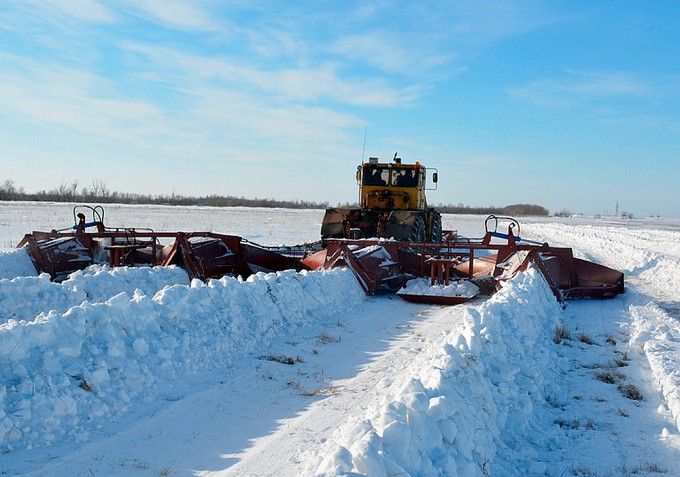
Against the background of a shortage of snow cover throughout the grain-growing belt, farmers, as far as possible, preparing for the dry season, carry out snow retention.
In turn, the employees of the Research and Production Center for Grain Farming named after. A.I. Baraev is advised to carry out the first snow retention in the presence of snow cover in the fields with a height of 12-15 cm.
According to their recommendation, in the absence of snow on the fields, one should wait for the accumulation of snow cover at a level of 12 cm and wait until a crust of 3-5 cm thick forms on the snow surface.
Experts note that a hard crust is usually formed under the influence of winds and frosts within a week. During the work of snow plows, the crust, collapsing, forms large blocks of snow. Snow rolls formed from large blocks of crust and ordinary snow, as a rule, are not blown by the wind. Severe frosts also affect the increase in the strength of snow rolls.
It is clarified that it is necessary to complete the snow retention by the end of January - the beginning of February in order to intercept the snow of February and March snowstorms.
Depending on the prevailing pre-winter soil moisture, the following is recommended:
snow retention is primarily carried out in the fields after non-steam predecessors (with a stubble height during harvesting less than 12-18 cm), where the reserves of productive moisture in a meter-long soil layer do not exceed 50-60 mm before leaving for winter;
obligatory snow retention in the fields after non-steam predecessors (with a stubble height during harvesting of 12-18 cm) with autumn tillage;
snow retention is carried out, if necessary, on flat-cut fallow fields, where deep tillage was carried out in autumn and pre-winter moisture reserves were below 80 mm;
the cutting of snow rolls must be completed, regardless of the agricultural background, before the end of January, and in exceptional cases, no later than the first decade of February.
With zero cultivation technology, the main method of accumulating and retaining snow is to leave high stubble during harvesting:
with a wheat yield of more than 16 c/ha, leaving stubble height of 18-27 cm,
at 10-16 q/ha - 25-30 cm.
On light soils with low yields (up to 10 c/ha), stubble wings 35-45 cm high are left, formed by strippers or stripper headers.
If high stubble or stubble fields are not left, the SVSH-10 wide-cut hydroficated snow rakes for class 5 tractors, SVSH-7 for class 3 tractors and trailed snow rakes SVU-2.6 are used to accumulate winter precipitation.
The site also notes that the need for mechanical snow retention also depends on autumn conditions. In years with a wet autumn, when there is 80-90 mm of moisture in a meter-long layer of soil before leaving for winter, it is necessary to accumulate 20 cm of snow, and in years with a dry autumn (30–50 mm of productive moisture) - 50-55 cm. the terrain must be taken into account.
On wind-impacted slopes, snow retention, as a rule, should be double. It is recommended to cut snow rollers with a snow cover height of 12-15 cm and the presence of crust of at least 5 cm. The distance between the tops of the rollers is 4-5 m, the direction is across the prevailing winds in winter.